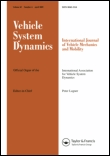
VEHICLE SYSTEM DYNAMICS
Scope & Guideline
Exploring the future of safe and efficient vehicle design.
Introduction
Aims and Scopes
- Vehicle Dynamics Analysis:
Research focusing on the dynamic behavior of various vehicles including rail, road, and off-road vehicles. This includes studies on stability, handling, and ride comfort. - Control Systems Development:
Development of advanced control strategies for vehicle systems, incorporating methodologies such as model predictive control, adaptive control, and fault-tolerant systems to enhance vehicle performance. - Simulation and Modelling Techniques:
Innovative simulation techniques, including multibody dynamics and finite element analysis, are utilized to model vehicle behavior and interactions with their environments. - Wheel-Rail Interaction Studies:
In-depth analysis of the interactions between wheels and rails, including wear mechanisms, adhesion, and the effects of track geometry on vehicle dynamics. - Advanced Suspension Systems:
Research into suspension systems, including semi-active and active suspension designs aimed at improving ride quality and stability. - Vehicle-Track Coupled Dynamics:
Studies examining the dynamic interactions between vehicles and track systems, focusing on the effects of track irregularities and vehicle design on overall system performance.
Trending and Emerging
- Autonomous Vehicle Dynamics:
A surge in research focused on the dynamics of autonomous vehicles, including trajectory tracking, sensor integration, and adaptive control systems, reflecting the industry's shift towards automation. - Machine Learning Applications:
An increasing incorporation of machine learning techniques for predictive maintenance, fault detection, and optimization of vehicle dynamics, highlighting the integration of AI in vehicle systems. - Sustainability and Energy Efficiency:
Research focused on enhancing the energy efficiency of vehicles and reducing their environmental impact is gaining traction, with studies exploring hybrid and electric vehicle dynamics. - Smart Tire Technologies:
Emerging interest in smart tire technologies that integrate sensors for real-time data collection and analysis, enhancing vehicle dynamics and safety through improved feedback mechanisms. - Digital Twin Technologies:
The adoption of digital twin technologies for real-time monitoring and simulation of vehicle dynamics is becoming increasingly relevant, allowing for more accurate predictions and optimizations.
Declining or Waning
- Traditional Mechanical Systems:
Research focused on conventional mechanical systems without integration of modern technologies or methodologies has seen reduced interest as the field evolves towards more advanced and integrated approaches. - Basic Vehicle Dynamics without Control Applications:
Studies solely aimed at fundamental vehicle dynamics without applying control strategies or modern computational approaches are becoming less frequent as the field progresses towards more complex and practical applications. - Historical Data Analysis:
The focus on historical data analysis for vehicle performance has waned, as researchers increasingly prioritize real-time data acquisition and analysis methods, leveraging advancements in sensor technology. - Static Analysis of Vehicle Performance:
Static analyses that do not consider dynamic or real-time factors are less common as the emphasis shifts to understanding dynamic interactions and their implications for vehicle design and safety.
Similar Journals

International Journal of Intelligent Transportation Systems Research
Optimizing Transportation Networks for a Smarter TomorrowInternational Journal of Intelligent Transportation Systems Research, published by Springer, stands as a premier platform for disseminating cutting-edge research in intelligent transportation systems (ITS). Established in 2010, this journal has made significant strides in addressing the complexities and innovations within the realm of transportation engineering, automotive technology, control systems, and information systems, reflected in its impressive categorization across diverse engineering and applied mathematics disciplines with notable rankings in Q2 and Q3 quartiles. With a steadfast commitment to advancing knowledge and fostering discussions that bridge academia and industry, the journal welcomes high-quality research articles, reviews, and case studies that explore emerging trends, technologies, and methodologies shaping the transport sector. Researchers, professionals, and students alike will find a wealth of insights aimed at optimizing operational efficiencies and enhancing safety and sustainability in transportation networks. As of 2023, the journal continues to thrive, seeking to compile contributions that align with its mission of improving transportation systems globally.
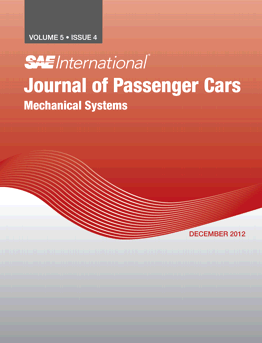
SAE International Journal of Passenger Cars-Mechanical Systems
Driving Innovation in Automotive MechanicsSAE International Journal of Passenger Cars-Mechanical Systems, published by SAE International, serves as a vital platform for researchers, engineers, and industry professionals focused on the dynamics of passenger vehicle mechanical systems. With an ISSN of 1946-3995 and E-ISSN of 1946-4002, this journal bridges academic research with practical applications in the automotive field. Although coverage in Scopus was discontinued after 2021, the journal has still contributed significantly to the realms of automotive engineering, safety, and mechanical engineering, evidenced by its Scopus rankings and percentiles across various categories, including a rank of #57 in Automotive Engineering. This multidisciplinary journal is key for those looking to advance their knowledge and explore innovative solutions in automotive mechanics, with an emphasis on enhancing vehicle performance, reliability, and safety. While current open access options are detailed further on their website, the journal continues to maintain a commitment to disseminating valuable insights that can shape future automotive technologies and practices.

Journal of Computational and Nonlinear Dynamics
Advancing the Frontiers of Computational Dynamics.Welcome to the Journal of Computational and Nonlinear Dynamics, a leading publication in the fields of applied mathematics, control and systems engineering, and mechanical engineering, published by the esteemed American Society of Mechanical Engineers (ASME). With an ISSN of 1555-1423 and an E-ISSN of 1555-1415, this journal has been a vital resource since its inception in 2006, promoting high-quality research and innovative methodologies aimed at solving complex engineering problems. With a commendable impact in academic circles, it ranks in the Q3 quartile for Applied Mathematics and Control and Systems Engineering, and Q2 for Mechanical Engineering as of 2023. The journal facilitates the dissemination of research findings, theoretical advancements, and practical applications, making it an essential platform for researchers, professionals, and students looking to advance their knowledge and engage with cutting-edge dynamics research. While currently not available as an open-access publication, subscribers benefit from a wealth of scholarly articles that contribute to the academic community's understanding of computational and nonlinear dynamics in various engineering disciplines.

eTransportation
Connecting Ideas for the Next Generation of MobilityeTransportation is a premier academic journal published by Elsevier, dedicated to advancing the fields of Automotive Engineering, Electrical and Electronic Engineering, Energy Engineering and Power Technology, and Transportation. Since its inception in 2019, the journal has achieved an outstanding reputation, maintaining a prestigious Q1 ranking across multiple categories in the 2023 Scopus rankings, including a remarkable top position in Automotive Engineering. With an impact factor reflecting its influence and rigorous peer-review process, eTransportation serves as a vital platform for researchers, professionals, and students alike, fostering innovation and disseminating vital research findings that shape the future of transportation technologies. Based in the Netherlands, it supports open access options that enhance the visibility and accessibility of research, ensuring scholarly engagement worldwide. As the field evolves, eTransportation is poised to lead discussions and advancements towards more efficient, sustainable, and intelligent transport solutions.
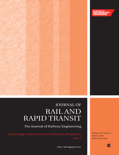
PROCEEDINGS OF THE INSTITUTION OF MECHANICAL ENGINEERS PART F-JOURNAL OF RAIL AND RAPID TRANSIT
Elevating Rail Engineering: Insights for a Sustainable FuturePROCEEDINGS OF THE INSTITUTION OF MECHANICAL ENGINEERS PART F - JOURNAL OF RAIL AND RAPID TRANSIT is a premier academic journal published by SAGE Publications Ltd, focusing on the latest advancements in rail transportation and rapid transit systems. With an ISSN of 0954-4097 and E-ISSN of 2041-3017, this journal has garnered significant attention in the field, achieving a Q2 category ranking in Mechanical Engineering and securing a Scopus rank of #192 out of 672, placing it in the 71st percentile. Covering converged years from 1989 to 2024, it provides a platform for innovative research and discussions that address the complexities and evolving technologies within the rail industry. Its publication draws contributions from esteemed researchers, professionals, and students alike, fostering a crucial dialogue on sustainability, efficiency, and advancements in transit infrastructure. While the journal is not open access, it remains a vital resource for those committed to pushing the boundaries of mechanical engineering and rail systems development.
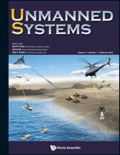
Unmanned Systems
Leading the Charge in Autonomous Vehicle AdvancementsUnmanned Systems is a leading academic journal published by WORLD SCIENTIFIC PUBL CO PTE LTD based in Singapore, that serves as a premier platform for research and advancements in unmanned vehicle technology. Covering a broad range of disciplines, the journal ranks in the Q1 category for Aerospace Engineering, Automotive Engineering, Control and Optimization, and Control and Systems Engineering as of 2023, showcasing its high impact within these fields. With impressive Scopus rankings placing it in the top tiers of its categories—8th in Control and Optimization and 14th in Aerospace Engineering—Unmanned Systems stands out as a vital resource for researchers, professionals, and students eager to explore current trends and innovations. While the journal operates under a traditional access model, it remains committed to disseminating quality original research, reviews, and case studies that contribute significantly to the understanding and application of unmanned technologies from 2013 through 2024.
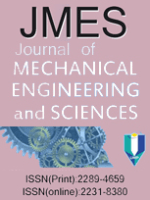
Journal of Mechanical Engineering and Sciences
Fostering Collaboration in Mechanical Engineering DiscoursesThe Journal of Mechanical Engineering and Sciences (ISSN: 2289-4659, E-ISSN: 2231-8380), published by UNIV MALAYSIA PAHANG, is a prominent open access journal established in 2011, dedicated to advancing the field of mechanical engineering and associated sciences. Covering a wide array of topics from industrial manufacturing processes to computational mechanics, the journal serves as a vital platform for researchers, professionals, and students to disseminate innovative findings and methodologies. With impressive Scopus rankings, including a place in the 60th percentile for Industrial and Manufacturing Engineering, the journal holds a significant position among its peers, facilitating global academic discourse. Located in Kuantan, Pahang, Malaysia, the journal emphasizes accessibility and collaboration within the engineering community, encouraging submissions that contribute to both theoretical and applied aspects of mechanical engineering.

Automotive Innovation
Pioneering the Future of Automotive TechnologyAutomotive Innovation is a leading academic journal dedicated to the advancements and transformative trends in the field of automotive engineering. Published by SpringerNature, this esteemed journal boasts an impressive Q1 ranking in Automotive Engineering for 2023, reflecting its high impact and relevance with a rank of #17 out of 125 in the Scopus database, placing it in the 86th percentile. Focused on publishing cutting-edge research from 2018 to 2024, it serves as an essential platform for researchers, professionals, and students interested in exploring the latest innovations, technologies, and practices in automotive design, manufacturing, and sustainability. Though not an open access journal, its commitment to advancing knowledge in automotive engineering makes it an invaluable resource for anyone invested in the future of transportation. For further insights and research findings, the journal can be accessed at its editorial office located in the United States.

International Journal of Dynamics and Control
Pioneering Research in Control MethodologiesInternational Journal of Dynamics and Control, published by SPRINGERNATURE, is a prestigious academic journal aimed at advancing the fields of Civil and Structural Engineering, Control and Optimization, Electrical, Electronic, and Mechanical Engineering, as well as Modeling and Simulation. With an ISSN of 2195-268X and an E-ISSN of 2195-2698, this journal focuses on high-quality research that addresses complex dynamic systems and control methodologies essential for innovation and progress in engineering disciplines. The journal has achieved significant recognition, being ranked in the second quartile for multiple categories in 2023, which underscores its impact and relevance within the academic community. Although it operates under subscription access, its rigorous peer-review process ensures that published articles meet the highest standards of scientific excellence. Researchers, professionals, and students alike will find valuable insights and methodologies that inform their work and inspire future studies in dynamic systems and controls.
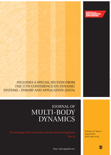
PROCEEDINGS OF THE INSTITUTION OF MECHANICAL ENGINEERS PART K-JOURNAL OF MULTI-BODY DYNAMICS
Exploring Innovations in Mechanical EngineeringPROCEEDINGS OF THE INSTITUTION OF MECHANICAL ENGINEERS PART K-JOURNAL OF MULTI-BODY DYNAMICS, published by SAGE PUBLICATIONS LTD, stands as a pivotal platform for research dissemination in the fields of Mechanical Engineering and Condensed Matter Physics. With an ISSN of 1464-4193 and an E-ISSN of 2041-3068, this journal covers a broad spectrum of topics related to multi-body dynamics, aiming to facilitate the exchange of knowledge among researchers, professionals, and students alike. With its impressive ranking in the Q2 category for both Mechanical Engineering and Condensed Matter Physics, the journal is recognized for its quality and relevance, placing it within the top 64th and 58th percentiles of its respective fields according to Scopus rankings. Housed in the United Kingdom and accessible via various academic platforms, this journal operates without an open access policy, ensuring rigor in the peer-review process. By bridging theoretical understanding and practical applications, the journal continues to contribute significantly to advancements in multi-body dynamics, making it an essential resource for those engaged in cutting-edge engineering research.